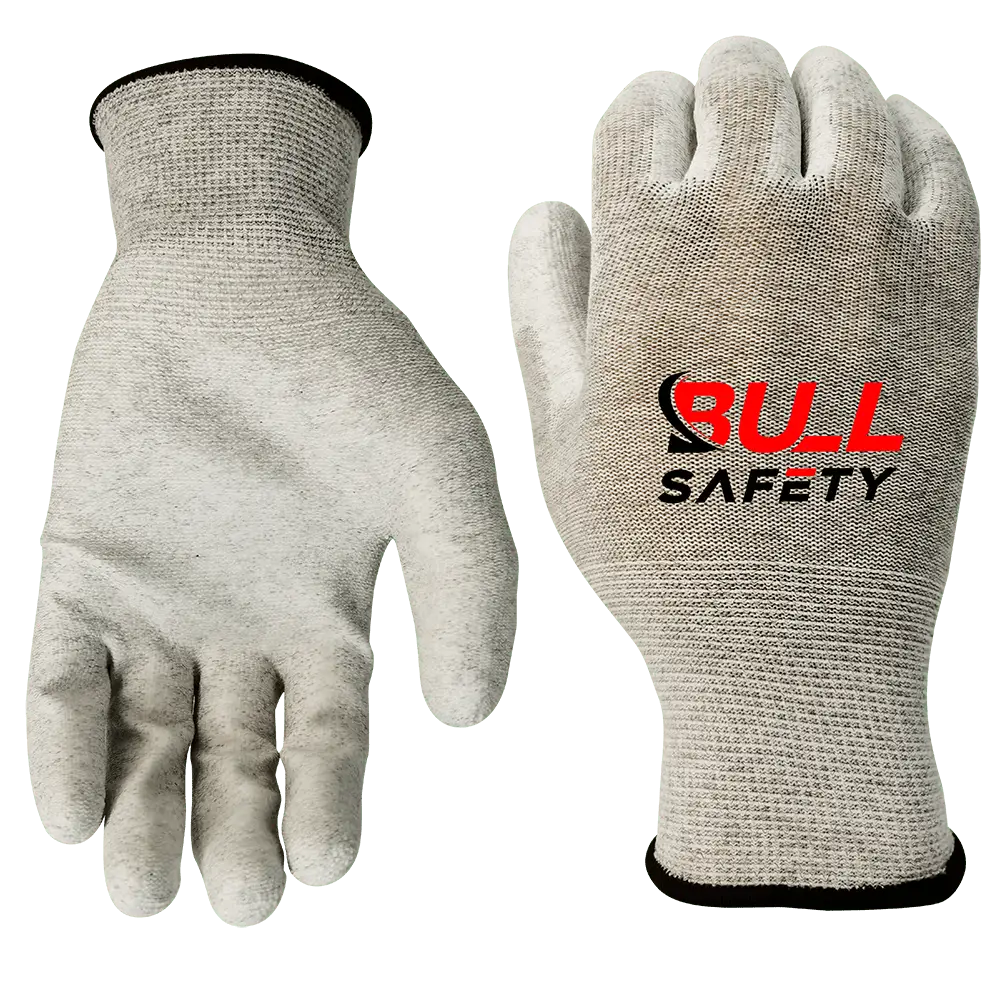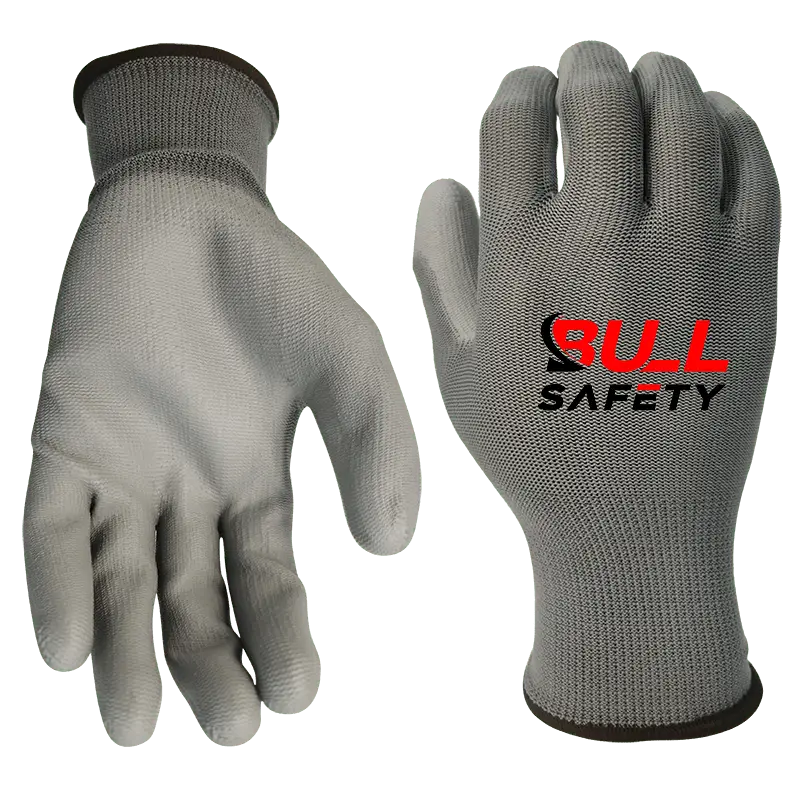PU gloves are an essential part of personal protective equipment (PPE). They combine comfort, flexibility, and protection, making them popular in various industries. But what exactly are PU gloves, and why are they so important?
PU gloves are gloves coated with polyurethane, offering a balance between protection and dexterity. They are commonly used for tasks requiring fine handling and protection from abrasions.
PU gloves are widely used across different sectors, but many still wonder about the details behind their composition and performance. Let’s dive into the specifics to better understand these gloves and their features.
What is PU coated mean?
Understanding what PU coating means is essential for evaluating the protection and functionality of these gloves.
PU coating refers to a layer of polyurethane applied to the gloves’ surface. It enhances the gloves’ durability, grip, and resistance to abrasion while maintaining flexibility.
 Bullsafety 13 gauge carbon fiber gloves with PU palm coating for enhanced protection and grip.
Bullsafety 13 gauge carbon fiber gloves with PU palm coating for enhanced protection and grip.
PU coating is a type of synthetic material that creates a smooth, protective layer over the gloves. The coating allows for precise handling, even in oily or wet conditions, making these gloves ideal for light industrial work or tasks that require dexterity. The layer is lightweight, and it doesn’t interfere with the hand’s natural movement. However, the level of protection depends on the thickness of the coating and the type of gloves.
When evaluating PU-coated gloves, it’s important to consider:
- Grip: PU-coated gloves provide excellent grip, especially for delicate tasks like assembly or handling small parts.
- Flexibility: Unlike some rubber-coated gloves, PU coatings maintain high flexibility, allowing workers to use their hands naturally.
- Durability: The durability of PU coating varies depending on the application and material used. It’s generally suitable for light to medium-duty work but may wear down faster under heavy usage.
Types of PU Coatings
| Coating Type | Durability | Grip Level | Best for |
|---|---|---|---|
| Standard PU Coating | Medium | High | General handling, assembly |
| Microfoam PU Coating | High | Very High | Wet environments, precision tasks |
| Polyurethane-Latex Hybrid | High | High | Handling rough or abrasive materials |
Does PU coating wear off?
Many people wonder how long PU-coated gloves last and whether the coating wears off with use.
Yes, PU coating does wear off over time. The wear depends on the intensity and type of work performed, but generally, lighter tasks result in slower wear.
PU coatings, while offering strong protection initially, can wear off due to repetitive use, especially in environments where gloves are exposed to harsh friction, oils, or chemicals. The coating’s wear rate also depends on the glove’s thickness and how well it was applied during manufacturing.
Factors that influence the wear of PU coatings include:
- Work Environment: High abrasion environments or contact with harsh chemicals can cause faster deterioration of the coating.
- Usage Frequency: Regular use, especially in heavy-duty tasks, accelerates wear.
- Glove Quality: The application of the PU coating, thickness, and glove design play a role in its longevity.
To extend the lifespan of PU-coated gloves, it’s important to select the right gloves for the task and maintain them properly.
Is PU material waterproof or not?
One common question about PU gloves is whether they are waterproof or water-resistant. Let’s clarify this.
PU gloves are generally water-resistant, but not fully waterproof. They offer protection against light moisture, but prolonged exposure to water may cause the coating to weaken.
PU material is known for being water-resistant, which makes it suitable for tasks where light moisture exposure is a concern, such as handling damp materials or working in humid environments. However, it is important to note that PU-coated gloves are not completely waterproof. Prolonged exposure to water or immersion can cause the coating to degrade and reduce its effectiveness.
For environments requiring complete waterproofing, other materials like nitrile or latex may be more suitable. However, for tasks like handling small parts in a slightly wet environment, PU gloves will provide enough protection.
Waterproof vs. Water-Resistant Gloves
| Material | Waterproof | Water-Resistant | Ideal for |
|---|---|---|---|
| PU Coating | No | Yes | Light moisture exposure, indoor work |
| Nitrile Coating | Yes | No | Heavy wet conditions, chemical handling |
| Latex Coating | Yes | No | Waterproof tasks, medical use |
What is the normal liner for PU gloves?
The type of liner inside PU gloves plays a critical role in comfort and protection. Let’s explore the most common liners used.
PU gloves typically feature a liner made of polyester, cotton, or a blend of both. This liner helps with comfort, breathability, and moisture absorption.
PU gloves come with different types of liners depending on the intended use and level of comfort required. The most common liners include:
- Polyester Liners: These are lightweight, breathable, and provide a snug fit. They are ideal for tasks that require flexibility and comfort over long periods.
- Cotton Liners: Soft and comfortable, cotton liners help absorb sweat and improve comfort for the wearer, especially in hot working environments.
- Nylon/Polyester Blends: A combination of nylon and polyester is used in many PU-coated gloves for enhanced durability and strength, offering a balance between comfort and protection.
Some high-end PU gloves might feature seamless knit liners for better flexibility and to avoid irritation from seams.
Common Liner Types for PU Gloves
| Liner Type | Features | Best for |
|---|---|---|
| Polyester | Lightweight, breathable, snug fit | Precision tasks, long-term wear |
| Cotton | Soft, moisture-absorbing, comfortable | General work, comfort-based tasks |
| Polyester/Nylon | Strong, durable, flexible | Heavy-duty tasks, durability |
What’s the standards of PU gloves?
PU gloves must meet certain standards to ensure they offer reliable protection. Let’s take a look at the most common standards applied to PU gloves.
PU gloves are commonly tested for abrasion resistance, puncture resistance, and other safety features. Standards like EN 388 and ANSI provide key performance guidelines.
PU gloves are tested against various standards to ensure their performance and safety. Some of the key standards include:
- EN 388: This European standard tests gloves for abrasion resistance, cutting resistance, tearing resistance, and puncture resistance. PU gloves often achieve good scores in abrasion resistance, making them suitable for tasks that involve handling rough materials.
- ANSI/ISEA 105: This standard is widely used in the US and tests gloves for cut, puncture, and abrasion resistance, as well as grip and dexterity.
- Oeko-Tex Certification: For gloves used in sensitive environments, Oeko-Tex certification ensures that the materials used are free from harmful chemicals.
These standards ensure that PU gloves provide adequate protection for workers while maintaining comfort and flexibility.
Key Standards for PU Gloves
| Standard | Focus Area | Importance |
|---|---|---|
| EN 388 | Abrasion, cut, tear, and puncture resistance | Commonly used for general work gloves |
| ANSI/ISEA 105 | Cut, puncture, and abrasion resistance | Focuses on safety in the US market |
| Oeko-Tex | Chemical-free materials | Important for sensitive skin or medical use |
Conclusion
PU gloves offer excellent protection for a wide range of tasks. Understanding their coating, durability, and certification helps make informed decisions about their use.




